
One of the best things about flying is the ability to see wondrous sights from a point of view few people ever have. It’s a rare privilege to venture to some of the most remote parts of the country so quickly, especially considering the alternative might involve cross-country travel by snowshoe or mule. Wilderness airstrips provide splendid access to these national wilderness treasures.
Bob Bement, now 81, is a fellow who knows a good thing when he sees it. He rises at dawn almost every morning to enjoy coffee and muffins with his friends in Vale, Oregon, at a coffee-shop/video-rental store. Once all the tales all told for the morning, ribbing accomplished, jokes and gossip shared, most of the coffee drinkers head for work or hobbies or the day’s first nap. Bement is likely to go to the local airport, Miller Memorial Airport (S49), where he has served as volunteer manager for the past 30-odd years.
If the weather is pretty, especially if he has a willing passenger, he may be readying his 1959 Cessna 182 for a flight to Oregon’s outback or Idaho’s mountain wilderness.
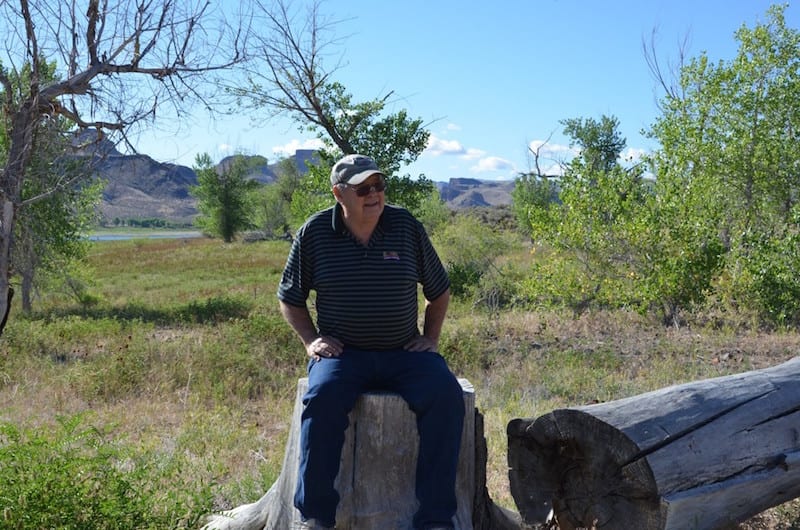
Bob Bement (Photo by Amelia Reiheld)
He has a list of favorite spots, some that look like old Wild West movie sets, and some that look like scenes straight out of survival flicks.
His flights often involve following winding rivers through mountain valleys, surrounded by steep, forested canyon walls. He may be landing on a short dirt strip beside a desert reservoir, dropping a buddy off on a dusty road on a remote ranch, or conjuring up a tiny landing strip along a river that wasn’t there a minute ago.
What the runways have in common is that they’re short, narrow, and unpaved. And they’re a long way from town.

Bob’s plane by a dry lake bed. (Photo by Carol Skerjanec)
Bob’s back-country proselytizing on an aviation Internet forum (Purpleboard.net) won him an unlikely convert a couple of years ago. Dan Figueroa, 44, a quiet Bostonian, was used to his inner-city kind of jungle, flying his Cherokee 140 in busy Class B airspace, over tall buildings, between long, wide paved towered fields. He doesn’t seem the kind of guy given to wild impulses.
The soul of hospitality, Bob Bement kept urging his fellow Purpleboard pilots to come to Oregon and let “Old Bob” show them what real flying was about. Dan still isn’t sure what got into him, but soon he had an airline ticket to Oregon.
The coffee shop crowd got wind of this big-city stranger from back east coming to visit, and circled the wagons. Bob had recently lost his wife of 60 years to cancer, and his protective friends were concerned, if not downright suspicious.
Vale attorney Carol Skerjanec admits her investigative skills revealed more about poor Dan than he likely knew about himself. The first duty when he arrived in Vale was to pass early-morning muster with the Vale coffee group. On being warned of their concerns, Dan dubbed the group The R.E.D Team, for retired-and-extremely-dangerous. It stuck, and soon they all had scarlet T-shirts disclosing their membership.
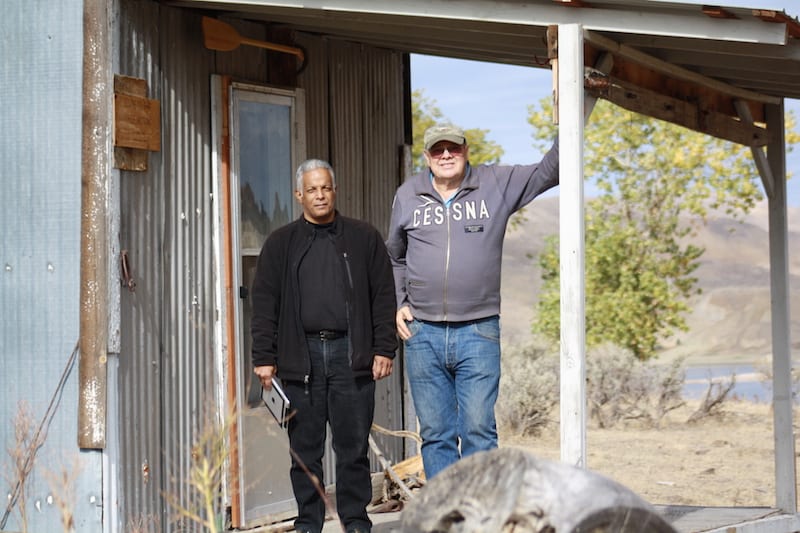
Dan and Bob. (Photo by Carol Skerjanec)
Carol, for her part, colluded with Bob as to the best use of avgas for Dan’s visit, and made plans to show him some of the finest wilderness airstrips in the area. The first day was perfect for three airstrips near Vale, including the Owyhee Reservoir, a dry lake bed still strewn with World War II ammunition, and a popular café with its own landing strip.
The following day they’d planned to head into the rising sun, to check out the Oregon mountains. It being late October, though, Mother Nature, naturally, tossed them a curve, and the three of them decided to fly north toward Red’s Horse Ranch and the Minam Lodge instead.
A phone call to the lodge reported decent weather, and they landed for a fine breakfast. They took off down the valley, and ran smack into a surprise snow storm on departure.
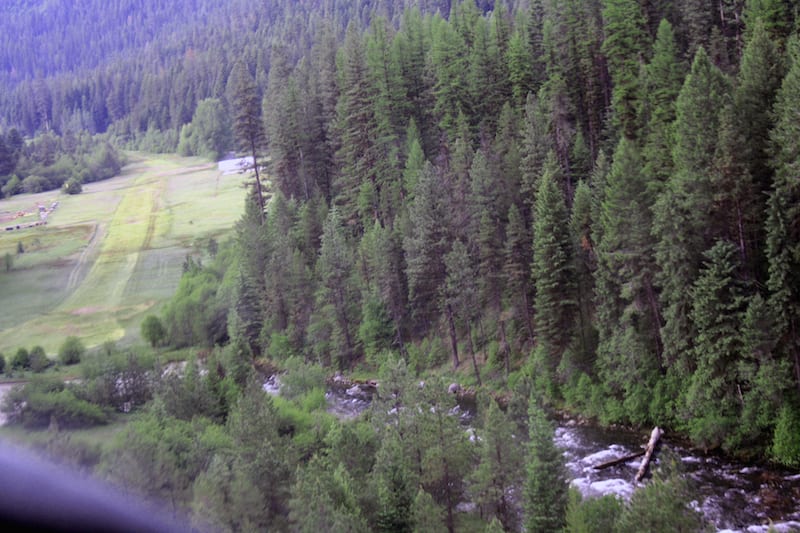
Landing at Minam (Photo by Carol Skerjanec)
No debate, the flight was cancelled for now, and Bob did a nice canyon U-turn back to the Minam’s airstrip. It was the last weekend for lodge employees, who were busy buttoning the buildings up for a long winter, but the three friends were made welcome, with cots, sleeping bags, and extra wood for the fireplace.
The Boston boy swears it was among his best adventures ever.
Since then, several of Bob’s Purpleboard friends, including yours truly, have seen the Northwest backcountry through the windscreen of his vintage 182.

Landing at the Johnson Creek Airstrip. (Photo by Carol Skerjanec)
He does make it look easy, dropping his bird into strips scarcely long enough to park a minivan. Strips not visible until short final around a 130° bend in the river. Strips bounded by tall trees, canyon walls, a hogback ridge on one end, and steep mountains on the other. Short, narrow strips that look like just another piece of undifferentiated desert, strewn with rocks and ridges, marked only by a dancing windsock, with cliffs diving into deep water at both ends.
So it was the morning Bob offered to take me down to the Owyhee Reservoir. He said he wanted to show me the Owyhee Hilton overlooking the mountains and a big wilderness lake.
It was a popular fly-in destination, he said. Carol agreed. The view from the rocking chairs on the porch, she assured me, was spectacular. And there was this logbook of visitors that included pilots from around the world.
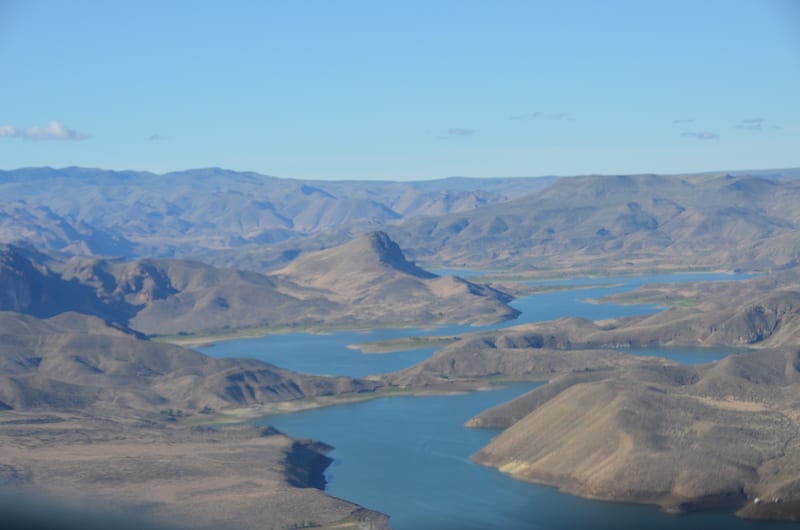
Flying to Owyhee. (Photo by Amelia Reiheld)
It was everything they promised and more. The fancy resort I imagined was my own mental aberration, entirely unconnected with reality, but Carol was right: Very few places have a finer, more relaxing front porch than that shabby, tiny cabin tucked between the cottonwood trees, overlooking the Owyhee Reservoir.
The Problem With Backcountry Flying
The problem with backcountry flying is that it’s everything you haven’t been taught about flying in flatland low country.
“You can’t make a standard downwind, base, final, landing pattern, “ Bob explains. “Problem is you have to interpolate.”
He goes through a litany of things to consider.
First, he urges low-country pilots to seriously consider the effects of Density Altitude. Sea level pilots don’t give leaning for takeoff much thought, but he insists that failure to lean properly for the much thinner air at 5,500 feet or more, along with failure to realize how much mid-day warming degrades takeoff performance, has killed too many pilots. Many accidents attributed to overloading are, he postulates, simply due to improper mixture control.
“It’s a good idea to fly in the early mornings, and get the plane on the ground by 10 a.m., not only for density altitude, but also, gusty winds that tend to kick up as the ground warms,” he advises.
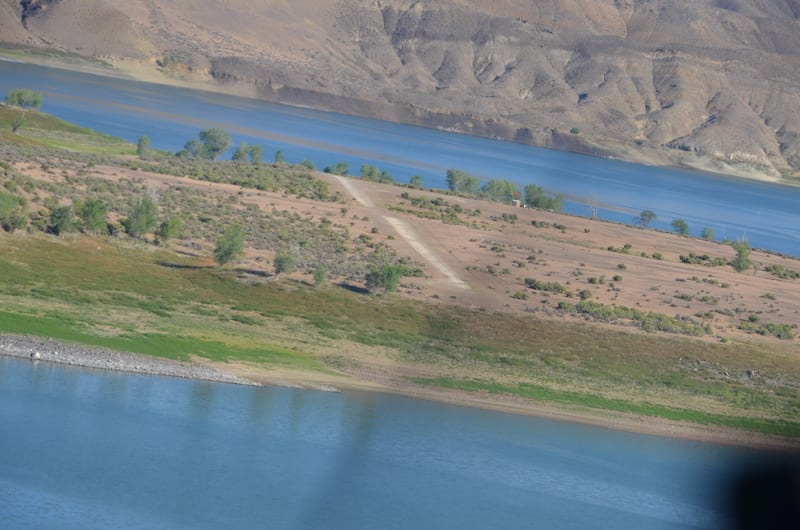
Owyhee Airstrip (Photo by Amelia Reiheld)
Weather in the backcountry can be unforgiving, with not only high winds, but lingering fog, ice, and more. The forecasts aren’t necessarily very accurate, as the wilderness airstrips are far from reporting stations. A skeptical weather eye, and a willingness to stay put or scrub the trip until conditions improve are both valuable. One phone call, when possible, is worth a whole lot of NOAA weather guesses.
“It’s easy to get turned around up here, too, “ he notes. One canyon can look a lot like all the others, and there may be no way out of the wrong one. “There’s a lot of little tricks to the trade you need to learn, like going over to the upwind side of the hill can get you a little extra lift, can help you out sometimes.”
Although Bob confesses he jumped right into the mountain-flying adventure after a single ride into the spectacular Mackay Bar, it does take some skill, often acquired the exciting way. After that first ride as a passenger into Mackay Bar, he came back in his own airplane.
“First time I came around that bend in the creek, and over that hogback ridge and saw the airstrip, I thought I was way high, and I was a little concerned,” he recalls.
It seems the steep canyon walls and towering mountains at the other end offered poor go-around options. He made it in, though, with only a slightly elevated heart rate.
Bob also encourages flatlanders to take a mountain flying course.
The Bob Bement Fan Club
Bob often takes his youngest brother, Ron, 65, along for the ride. Ron, born with Down Syndrome, is the proudest member of the unofficial Bob Bement Fan Club. Ronnie loves the chance to “fly” the airplane. He dons his headset, just like his brother, carefully fastens his seatbelt, and follows through on the control inputs with serious intent and a wide grin. Bob and Ron also ride a tandem bicycle around town, waving to neighbors.
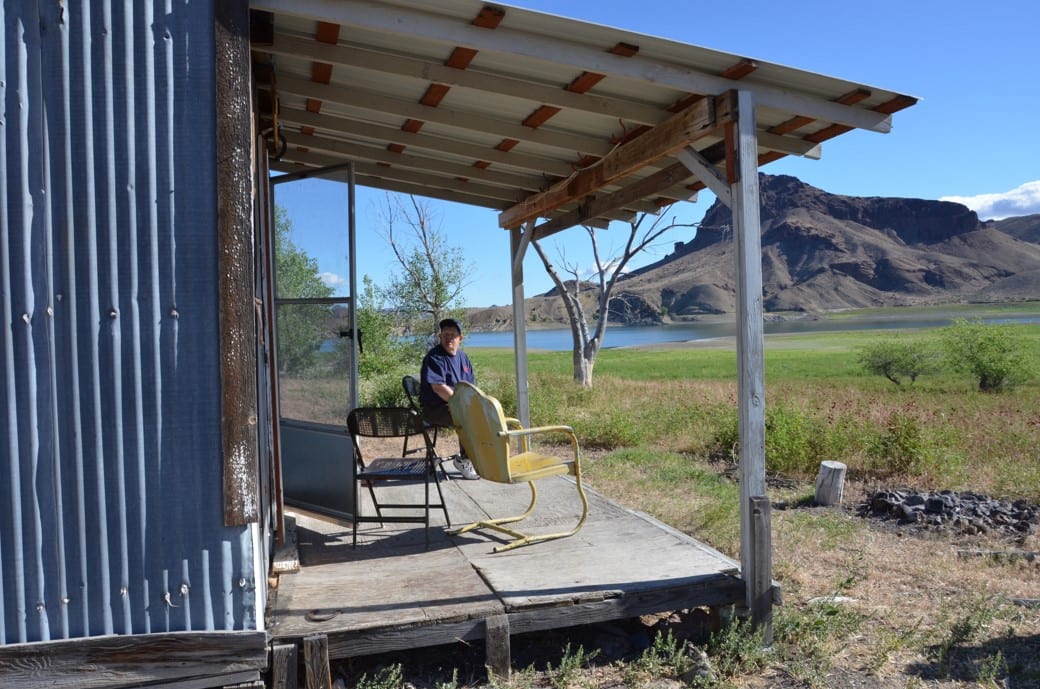
Ron Bement on the veranda of the Owyhee Hilton (Photo by Amelia Reiheld).
Bement was a longtime coach for the Vale High School Vikings, for basketball, football, and track. He taught an entire generation of its citizens how to drive. He rarely misses a home game.
Whenever there’s money to be raised for a good cause, for scholarships, for cancer research, for whatever needful thing pops up, Bob Bement is there, auctioning sightseeing rides to generous donors.
One such good cause is rebuilding the lodge at Big Creek that burned a few years ago. It was a popular breakfast destination beside the scenic Frank Church Wilderness Area. The logs for the new building go for $1,000 each, and Bob has his name on two of them. Now they’re starting to raise funds for the interior. Bob hopes to be having breakfast there again one of these fine days.
A few years ago, he was able to entice Berlin Candy Bomber, Gail Halvorsen, to his little town to speak. The speaker’s fee? A ride into the Chamberlain Basin for Halvorsen, who declined to fly his C-54 flying museum into 1,800 feet of mountain goat track.

Bob’s C-182 at Owyhee. (Photo by Amelia Reiheld)
Whenever the Malheur County Sheriff needs a pilot and a plane, Bob’s there to help with searches, providing a bird’s eye view over the county’s agricultural landscape and vast expanses of desert and rugged wilderness area, searching for lost hikers, rustlers, fugitives, and others who might have lost their way.
He’s also an enthusiastic supporter of the Recreational Aviation Foundation’s work to secure more aerial access to the Forest Service’s backcountry airstrips.
The Vale Chamber of Commerce recently awarded Bob Bement its Lifetime Achievement Award, citing a long list of good deeds and remarkable additions to the town’s well-being, but truth be told, it’s probably just as much for just being generous, easy-going, adventurous, kind, public-spirited Bob Bement, and one of Vale’s most beloved citizens.
If you’d like to ride shotgun with Bob Bement, his YouTube videos are a fun rainy day flying adventure. You can find his channel here.
Source: http://generalaviationnews.comStill flying the backcountry at 81